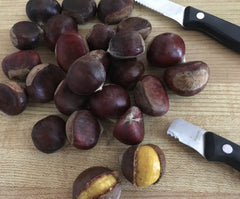
Chestnuts all over the northern hemisphere fall only in September and October. They are perishable, and must be refrigerated to delay spoilage, principally from molding. If allowed to dry, the chestnut kernel, being a living seed, will soon die and lose its natural enzyme protections against mold. (On the other hand, with a little drying their starch converts to natural sugars, which enhance the chestnut flavor.) Fresh chestnuts are ideally stored at temperatures of 32F at high humidity in mesh or other breathable bags. If stored in unvented plastic bags, the nuts will transpire and the trapped moisture will hasten molding. Stored in good conditions in your refrigerator, chestnuts should keep for a month or two.
Chestnuts can be frozen once they are peeled. Thawed chestnut kernels are great for recipes requiring purees and confections, and OK for soups, stews etc. We’ve used frozen chestnut kernels over a year old and if anything, they are simply sweeter!
But, our motto is: Eat ‘em, don’t store them!

Many, actually most, recipe books, internet advice and old fashioned habits tell you to cut an X in the back of the chestnut before roasting. We've found that a slice across the top “belly” makes peeling much easier. The nuts practically fall out without having to actually peel off the skin. But remember to peel while hot!!
Chinese chestnuts, such as we grow, are not only sweeter; they are comparatively easier to peel than most European varieties. There is the fast way---score across the middle, boil them in water for a few minutes, remove a few at a time, and peel with your fingers while hot. Sometimes the kernel will just pop out if you give it a little squeeze. For a better, more intense flavor, see the roasting instructions.
To roast fresh chestnuts, cut through the skin (see our instructions on the perfect chestnut knife), place in a covered pan and bake in a HOT oven at 375 until the nuts are tender. The inner paper skin will pop off better if both the pan (I like using a cast iron skillet) and the oven are preheated. Time in the oven is 15 minutes, more or less, depending on moisture content (freshness), the size of the chestnut and how soft you like them. I like them a bit “al dente”. Avoid roasting too long—they can dry out and become hard.
You can also roast chestnuts on the stove top on medium heat in a heavy pan, on a barbecue grill, microwave them (30 seconds or so for one or two nuts), or use an old-fashioned popcorn popper in the fireplace. TIP: roasted chestnuts peel easier when still hot, fresh out of the oven. And remember they can blow up, like popcorn, so to avoid too much fun and excitement, don't forget to pierce the skin.
 After scoring thousands of chestnuts, we discovered a way to make a perfectly good chestnut knife from a cheap, ordinary steak knife. Williams Sonoma makes a hooked chestnut knife, but it tends to cut deeply into the nut meat. Charlie took a serrated steak knife and broke it off to retain about ½ inch of serration which is just enough to cut through the skin. He ground and filed the rough top edge for safety. We thought "why keep this great idea to ourselves?" So take the idea and try it yourself. It will make your chestnut scoring life much brighter.
After scoring thousands of chestnuts, we discovered a way to make a perfectly good chestnut knife from a cheap, ordinary steak knife. Williams Sonoma makes a hooked chestnut knife, but it tends to cut deeply into the nut meat. Charlie took a serrated steak knife and broke it off to retain about ½ inch of serration which is just enough to cut through the skin. He ground and filed the rough top edge for safety. We thought "why keep this great idea to ourselves?" So take the idea and try it yourself. It will make your chestnut scoring life much brighter.
"We're looking forward to receiving the chestnuts. My son and his family are here visiting from the UK, and his wife who is from Portugal LOVES chestnuts. I ordered your chestnuts once before for them, and she think that yours are the best."
Mary, Minnesota